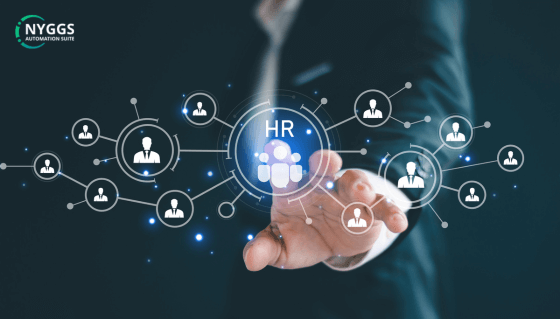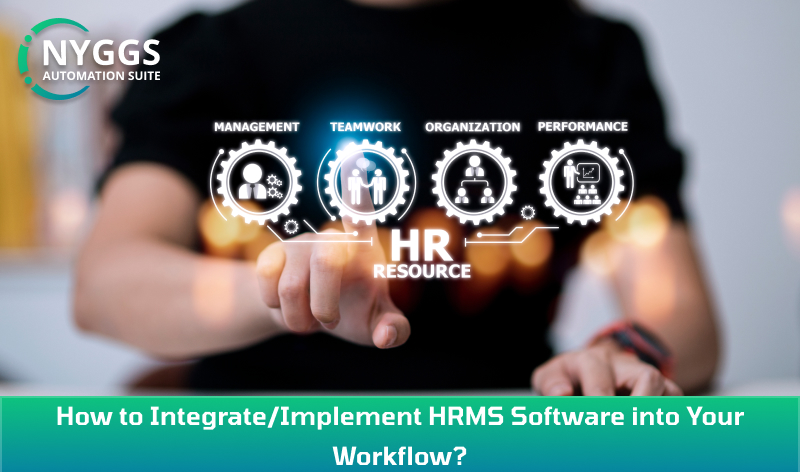Implementing HRMS Software in the organizational workflow is not a big deal. It involves a series of well-planned steps, including planning, research, execution, and implementation. However, if you’re already using HRM Software, making the switch becomes much easier and smoother. Moreover, it’s essential to acknowledge that human resource software users are well aware that the development phase never truly ends. As different scenarios arise, modifications become a requirement to adapt the software to evolving needs. Nevertheless, once the system is up and running, it proves to be a time-saving gem that ultimately translates into time & cost savings. Not only has that, but its accuracy in handling data left no room for human errors.
In this blog, we will guide you through integrating HRM software into your workflows, providing a comprehensive roadmap that starts with identifying your organization’s needs and ends with a fully functional system that enhances your human resource processes. By selecting the best HR software in India, you can ensure a seamless integration that optimizes your HR department management. So, let’s dive in and discover the world of efficient HR management!
How to Integrate HRMS Software to Your Workflows?
Integrating HRMS Software is a powerful way to streamline human resource processes and overall employee management. But the process doesn’t end with software deployment. Each organization has its own unique workflows, and employees operate with distinct structures. That’s why ongoing development is important.
Moreover, listening to users is key. By hearing users’ feedback, you can pinpoint challenges and allow developers to modify the software to our organization’s unique needs. This adaptability makes HRM Software compatible with any company in any industry.
In short, HRMS integration is transformative —shaping a more efficient and employee-centered organization.
To successfully integrate the HRMS System into your organization’s workflow, follow these steps:
Identify Your Requirements
The first step in implementing HRMS software is to identify the specific human resource functions you want the software to handle. For example, if you want to automate your attendance process, streamline payroll processing, and maintain a centralized database for all employee information, you can choose the best HR software in India equipped with these functionalities. However, it is important to consider your organization’s unique workflows while implementing the software.
Research and Selection of Software
When searching for HRMS system providers, ensure they offer solutions that match your needs. For businesses looking for the best HR software in India, it’s essential to have a well-defined budget for the software’s licensing and implementation. The software should be cost-effective and customizable to meet your specific requirements. Additionally, it should be compatible with mobile devices and easily integrate with other required or existing applications.
Train Your HR team
Training your human resource team is crucial to ensure they become proficient in using the new HRMS Software. After all, they are the end users responsible for streamlining overall HR tasks. Empowering your human resource department with comprehensive training will pave the way for a smoother and more efficient HRMS integration, ultimately benefiting the entire organization.

Data Migration & Integration
Data migration is the practice of transferring data from one system to another. It is a crucial consideration for any system implementation, upgrade or consolidation. Collaborate with your HRMS vendor to import existing data accurately and ensure seamless integration with other applications.
Furthermore, data integration is a process that combines different types of data, like datasets, documents, and tables, so users can use them for personal or business tasks. In other words, it allows data from various devices and in different formats to come together and work seamlessly. This makes it easier for everyone to access and use the information they need, regardless of how it was originally stored or what device it came from.
In summary, whether introducing a new software system or switching to a different brand, data migration and integration are vital components that require careful attention to ensure a successful and efficient transition.
Customize the HRMS Software
After the data has been migrated and integrated with the implemented software system, the next step is to customize the software to align it with the organization’s processes and workflows. They are, ultimately, making it efficient and user-friendly for your team.
For instance: The performance monitoring module in HRMS Software accommodates the employee’s performance evaluation workflow. Imagine you are implementing the HRMS system in your company with specific performance evaluation practices in which the human resource management department conducts quarterly performance reviews, and each review includes several key metrics to assess an employee’s performance.
Customization in Human Resource Management System
During the customization, the team can make many modules as given below.
Performance Evaluation Module
Performance Monitoring System (PMS) is a dedicated module within the HRMS suite to handle the performance evaluation process. This module allows managers to set up quarterly evaluation cycles, and define key performance indicators (KPIs), key responsibility areas (KRAs) and competencies. Also, enable them to specify the weightage of the components out of 100% & configure the evaluation criteria.
Customized KPIs, KRAs & Competencies
The PMS is designed to accommodate everyone’s unique KPIs, KRAs, and competencies, which align with the organization’s goals. Furthermore, these KPIs may include designation-based indicators, specifying what needs to be achieved to accomplish a particular objective (KRAs), while competencies refer to the essential skills or abilities required to perform a job and meet those specific objectives successfully.
With this level of customization, the HRMS System ensures that each employee’s performance evaluation is tailored to their role and responsibilities, which promotes better alignment with organizational objectives and fosters individual growth and development.
Automated Reminder System
The HRMS software can automatically remind employees and managers when performance evaluations are due, ensuring a timely evaluation process. It guarantees that everyone is on schedule and also helps to prevent delays.
Employee Self-Assessment
Before their performance reviews from management, employees can self-evaluate using the PMS module of the HRMS System. Employees can log in, provide feedback on their accomplishments, and create individual goals for the upcoming evaluation period.
Performance Reports
The configuration with different metrics enables the in-built AI algorithm of the software to generate comprehensive performance reports for each employee. These reports compile data from the evaluations, employee self-assessments, and manager feedback, presenting a holistic view of an employee’s performance. As a result, management can analyze performance trends over time, identifying patterns and areas for improvement.
Overall, it is just the tip of the iceberg. HRMS Software offers extensive customization with each module, allowing you to configure the setup and functionality to meet your specific requirements. Whether it’s Attendance Management, Leave Management, Employee Management, task management, or Compliance and Payroll Management, the software provides complete flexibility for tailoring the system to your organization’s needs.
Test the System
Conduct thorough testing of the entire HRMS System before and after deployment to identify areas that might require improvement. Test each and every functionality of all modules that are operational in your system. This testing ensures that during real-time operations, the system does not generate any errors that could disrupt the functions of any department.
Monitor and Gather Feedback
Continuously monitor the software’s performance, and gather feedback from users like human resource staff and employees to identify areas for improvement.
After all, these steps lead to your organization being empowered with state-of-the-art HRMS Software that seamlessly automates all your Human Resource Management processes.
Conclusion
As you can see, implementing the HRM system is not a complex task. You can easily implement it as a project with the right approach and adequate preparation. Moreover, having an IT support provider as a partner, especially if the vendor doesn’t offer support, is crucial for a successful implementation. However, NYGGS Automation Suite can also assist you throughout the implementation process.
Remember that introducing new HRMS Software varies based on individual priorities, such as company size, human resource software solution, and objectives. Each company’s planning steps will differ accordingly. The information provided in this blog is merely a basic outline and not a complete plan. For a comprehensive Human Resource Management project plan tailored to your needs, NYGGS HRMS will be the personalized option.
To learn more, contact NYGGS today!







